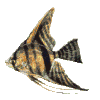| A BREEDING OF ELEGANCE
TRICHOGASTER LEERI
by Leta Hansen
Of all the gouramis this is indeed my favorite. Both beautiful and peaceful.
These fish are native to the Malayan Peninsula, Sumatra and Borneo. They
grow to a length of five inches and are generally found in stagnant shallow
waters in which there is lots of vegetation.
I bought a pair of these beauties at our Annual Show and after a few
weeks of conditioning they spawned.
The fish were put in a divided tank two-thirds full with aged water. The
temperature was kept about 80oF with slightly acid water. The two fish
were maintained like this for approximately two weeks. They were fed
live and freeze dried worms, and flake food.
When the female was plump with eggs, the divider was lifted and the
female released. She proved to be quite a challenge for the male. She's'
since received the nickname, "the tease".
The nest was made with Watersprite and bubbles which are formed from
air which is held in the labyrinth and then released when mixed with
saliva. When finished the nest was several inches in diameter.
The male would entice the female to the nest and as she nuzzled his flank
he would encircle her, flip her over, and squeeze her until the eggs were
released. The eggs were opaque and would float up into the nest. The male
would grasp them and spit them where he wanted.
After several hours the female was allowed to swim to her side of the
tank. The divider was put back down. The male was left to tend the eggs.
At this time Methylene Blue was added to the water, to help locate
fungused eggs, (which I removed with a baster) also I think it gives them a
little more protection. Hatching started in twenty four hours, with the
young free swimming in two more days. Once the fry were free swimming,
the male was then removed.
The fry were fed Liquid Fry food at first then powdered food, finally after
a few days the could eat freshly hatched Brine Shrimp.
At two weeks of age Acriflavin was added as a precaution against Velvet
at half the recommended strength. Every other day partial water changes
are given to help clean up uneaten food and debris.
I highly recommend these fish, not only for their compatibility but their
elegance in the home aquarium.
Reprinted with permission from The Kitsap Aquarian, publication of the Kitsap Aquarium
Society, Inc., October, 1988, p.5. |
